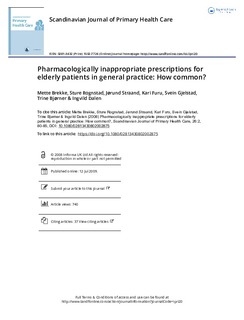| dc.contributor.author | Brekke, Mette | |
| dc.contributor.author | Rognstad, Sture | |
| dc.contributor.author | Straand, Jørund | |
| dc.contributor.author | Furu, Kari | |
| dc.contributor.author | Gjelstad, Svein | |
| dc.contributor.author | Bjørner, Trine | |
| dc.contributor.author | Dalen, Ingvild | |
| dc.date.accessioned | 2017-06-07T12:40:56Z | |
| dc.date.available | 2017-06-07T12:40:56Z | |
| dc.date.issued | 2008 | |
| dc.identifier.citation | Brekke, M., Rognstad, S., Straand, J., Furu, K., Gjelstad, S., Bjørner, T. & Dalen, I. (2008) Pharmacologically inappropriate prescriptions for elderly patients in general practice: how common? Scandinavian Journal of Primary Health Care, 26(2), s. 80-85. | |
| dc.identifier.uri | http://hdl.handle.net/11250/2445146 | |
| dc.description | Tverrsnittstudie, kartlegging av i hvor stor grad norske allmennleger (fastleger) foreskriver potensielt skadelige legemidler til eldre pasienter. | |
| dc.description.abstract | Objective. To assess Norwegian general practitioners’ (GPs’) level of potentially harmful drug prescribing for elderly patients. Design. Prescription data for 12 months were retrospectively retrieved from the Norwegian Prescription Database (NorPD). Data were assessed in relation to 13 prescription quality indicators. Setting. General practice. Subjects. A total of 454 GPs attending continuous medical education (CME) groups in Southern Norway, 85 836 patients ]70 years who received any prescription from the GPs during the study period. Main outcome measures. Number of prescriptions assessed in relation to pharmacological inappropriateness based on a list of 13 explicit prescription quality indicators. Results. Some 18.4% of the patients (66% females with mean age 79.8 years, 34% males with mean age 78.7 years) received one or more inappropriate prescriptions from their GP. An NSAID in a potentially harmful combination with another drug (7%) and a long-acting benzodiazepine (4.6%) were the most frequent inappropriate prescriptions made. Doctor characteristics associated with more inappropriate prescribing practice were old age and working single-handed with many elderly patients. Conclusion. The study reveals areas where GPs’ prescribing practice for elderly patients can be improved and which can be targeted in educational interventions. | |
| dc.language.iso | eng | |
| dc.subject | pasientsikkerhet | |
| dc.subject | legemiddel | |
| dc.subject | legemiddelbruk | |
| dc.subject | fastlege | |
| dc.subject | lege | |
| dc.subject | legemiddelinteraksjoner | |
| dc.subject | legemiddelforskrivning | |
| dc.subject | uhensiktsmessig legemiddelbruk | |
| dc.subject | legemiddelrelaterte problemer | |
| dc.subject | allmennmedisin | |
| dc.subject | allmennpraksis | |
| dc.subject | register | |
| dc.subject | reseptregister | |
| dc.subject | tverrsnittstudie | |
| dc.subject | eldre | |
| dc.subject | Norge | |
| dc.title | Pharmacologically inappropriate prescriptions for elderly patients in general practice: how common? | |
| dc.type | Journal article | |
| dc.rights.holder | Brekke, Mette | |
| dc.source.volume | 25 | |
| dc.source.journal | Scandinavian Journal of Primary Health Care | |
| dc.source.issue | 2 | |
| dc.identifier.doi | 10.1080/02813430802002875 | |
